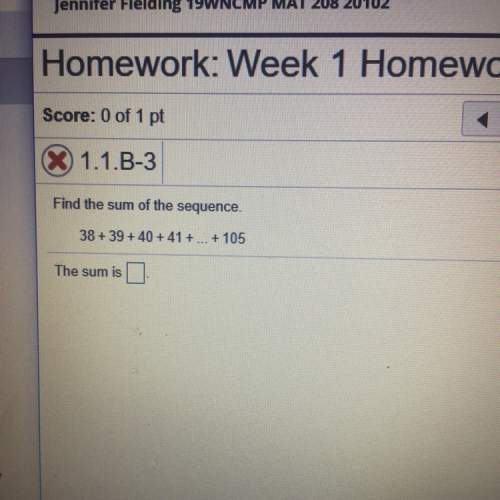Me,
mammy and his partner just adopted twins and have decided to adjust their monthly budget....

Mathematics, 06.10.2019 12:00 aurorasweetpea610
Me,
mammy and his partner just adopted twins and have decided to adjust their monthly budget. the couple has a monthly income of $6,600 and anticipate the following monthly expenses: $1.850 for mortgage, $400 for home insurance and property tax, $600 for utilities , $500 for food, $850 for car, $600 for health and life insurance, $500 for retirement, and $500 for expenses related to leisure.
a- if the couple decided to save the remaining money in an account for their children's college, how much can they save each month?
b- manny and his partner anticipate that they need $100,000 to pay their kid's college in 13 years if they save the amount calculated in part (a) every month for 13 years, will they reach their goal? why or why not?

Answers: 1


Another question on Mathematics

Mathematics, 21.06.2019 16:00
What is the quadric regression equation that fits these data
Answers: 1

Mathematics, 21.06.2019 17:00
In tossing one coin 10 times, what are your chances for tossing a head? a tail? 2. in tossing one coin 100 times, what are your chances for tossing a head? a tail? 3. in tossing one coin 200 times, what are your chances for tossing a head? a tail? deviation = ((absolute value of the difference between expected heads and observed heads) + (absolute value of the difference between expected tails and observed tails)) divided by total number of tosses. this value should always be positive. 4. what is the deviation for 10 tosses? 5. what is the deviation for the 100 tosses? 6. what is the deviation for 200 tosses? 7. how does increasing the total number of coin tosses from 10 to 100 affect the deviation? 8. how does increasing the total number of tosses from 100 to 200 affect the deviation? 9. what two important probability principles were established in this exercise? 10. the percent of occurrence is the obtained results divided by the total tosses and multiplied by 100%. toss the coins 100 times and record your results. calculate the percent occurrence for each combination. percent head-head occurrence: percent tail-tail occurrence: percent head-tail occurrence:
Answers: 3

Mathematics, 21.06.2019 19:30
I'm confused on this could anyone me and show me what i need to do to solve it.
Answers: 1

Mathematics, 21.06.2019 21:00
Which expression is equal to (21)(7)(3x) using the associative property? (21 · 7 · 3)x (7)(21)(3x) 32(7 + 3x) (3x)(7)(21)
Answers: 2
You know the right answer?
Questions

Mathematics, 18.05.2021 18:30

Mathematics, 18.05.2021 18:30

Mathematics, 18.05.2021 18:30

Mathematics, 18.05.2021 18:30

Mathematics, 18.05.2021 18:30

English, 18.05.2021 18:30



Chemistry, 18.05.2021 18:30


Geography, 18.05.2021 18:30



English, 18.05.2021 18:30

Mathematics, 18.05.2021 18:30



Mathematics, 18.05.2021 18:30


Social Studies, 18.05.2021 18:30




